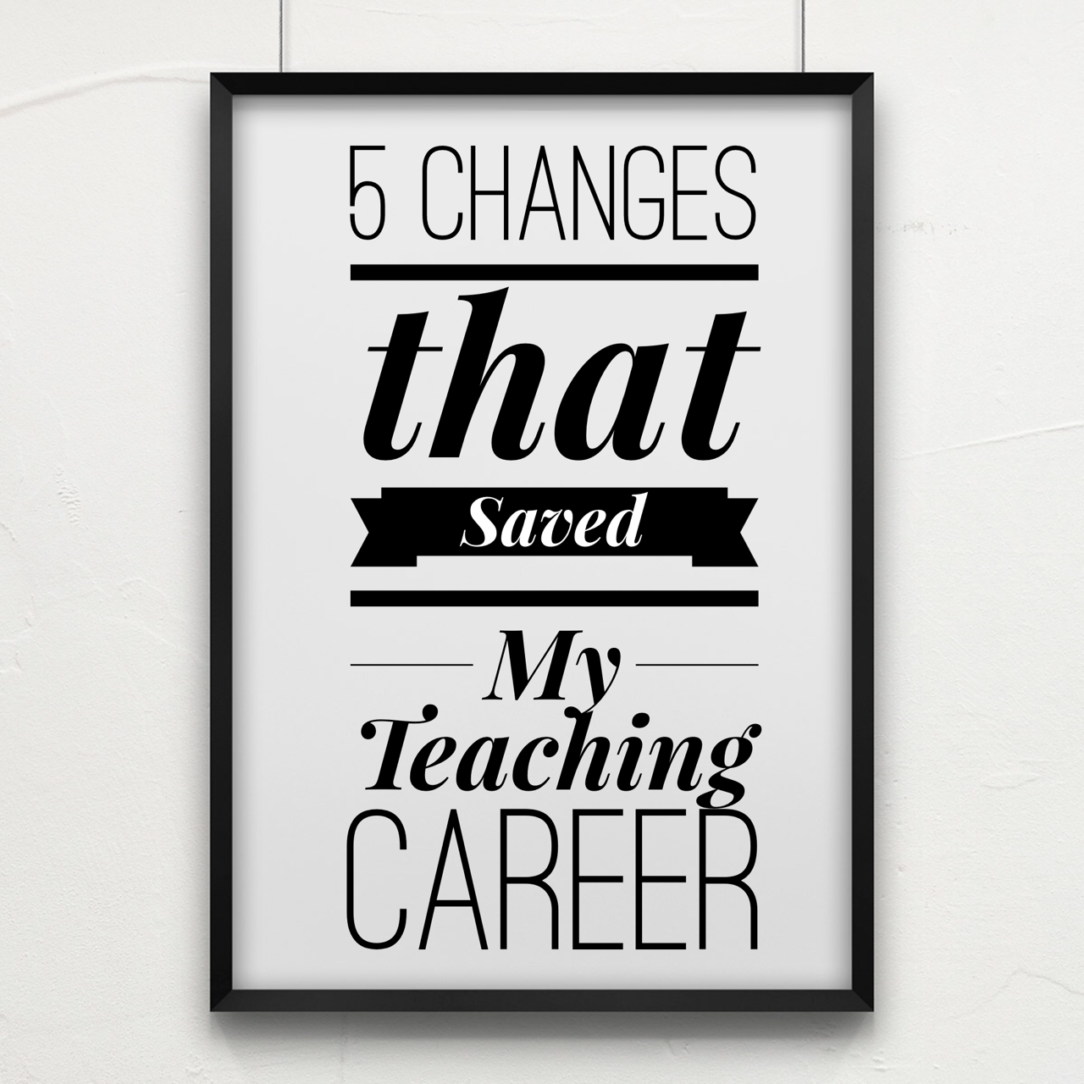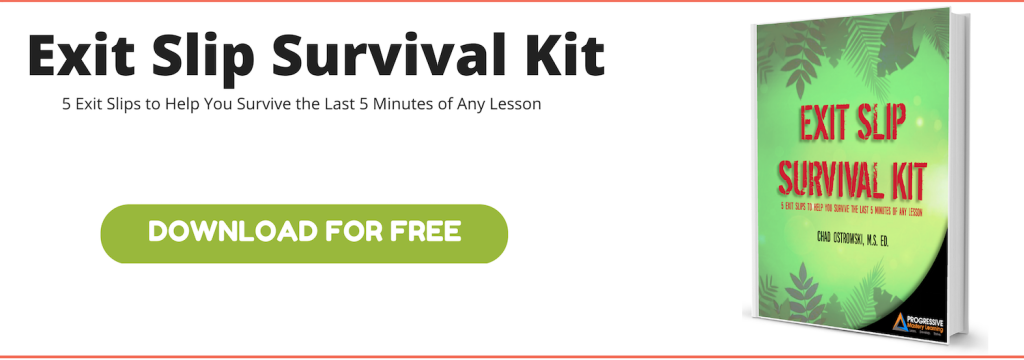Watch the video!
I had the most difficult and challenging year of my life in the classroom last year. I had a ton of management issues, low student performance, and basically anything else that could go wrong went wrong.
After a year like that, I knew I had two options: look for another line of work (like Burger King, for example), or make some drastic changes in my instruction. I thought I had teaching down; I was an expert in Problem Based Learning and formative assessment, and I thought I was pretty good at lesson design and class management. But my classroom did not look like an expert teacher was at the front of the room.
It was easy to “blame the kids.” I’d be putting it lightly if I said they were a difficult group, but that doesn’t mean I couldn’t make adjustments and adapt in order to never let a year like that happen again. After careful reflection, I came up with 5 things to change.
Since making these changes, my students are learning more than ever, my management issues are much lower, and as an added bonus, I love going to work everyday and I have found my passion again for education.
Now, I really hope you’e not having a year like I had, but I believe some of these changes can be beneficial to any educator:
1. Plan backwards.
All too often, teachers are sifting through files on their computers or binders full of lessons, tasks, or activities they have from the previous year. We find something that looks good, and say, “yup! That’s what I’m doing tomorrow!” Then we slap a learning target on the board, in case an administrator walks in, and call it “standards-based.” To be honest, I’ve been guilty of this many times. Depending on the students, class size, and other obligations you have, teaching turns into “survival” more than intricate planning, preparation, and data driven instruction. This means you need to shift your focus and put some time in beforehand.
Before you start a unit, you should decide exactly what your learning targets are going to be, and tier them so they build in complexity as your students learn more. Once your targets are completed, you need to develop essential questions for each target (ex: 5 questions for each of your 4 targets). This will give you ammunition for your formative assessments and allow you to essentially complete your summative assessment items before you even begin the unit!
You can then take these targets and carefully use your binders, files, and prior activities to align meaningful learning experiences for your students.This will also reduce the amount of “fluff” or “random acts of coolness,” in your curriculum and make your instruction more efficient.
2. Let learners set the pace.
The shift that allows learners to set their own pace is perhaps one of the most challenging changes I have made, but it has been the most rewarding. A lot of times, as teachers, we are so worried about “getting through” our material that we end up leaving our students in the dust. I was all too familiar with this feeling and a lot of times taught accordingly. This year I have let my students decide when we move onto a new topic based on their mastery of content, not my calendar on the wall.
Now…I know what your thinking, “What about the students that are behind?”, or “What about the students that don’t get through everything???” My conclusion, and something I have come to terms with, is that I would prefer my students to only get through 70% of the information, but know it really well, rather than get through 100% of the information and only understand 10% of it because it was over their heads. Proper scaffolding is essential to understanding content.
If students are “stuck” on a concept, they will have a hard time understanding the more complex concepts that follow. You must allow them the time to build a foundation, so when they reach the higher tiered targets, they will be able to grasp concepts easier and find more success every day. This year I have developed a method to structure and implement my curriculum based on this foundation and the results have been amazing.
3. Hold students accountable for learning.
Another huge shift I have made this year is the implementation of mastery learning in my classroom. Students are formatively assessed after EVERY (yup, I said EVERY) task they complete. This is okay, because I planned ahead (by planning backwards) to ensure that all of my learning opportunities are aligned with the standards based targets from Change #1. Did you do that yet?
I do not let students move on until they have completed a formative/summative assessment or project with at least 85% competency. They are also only graded on their mastery of individual targets, NOT on completion of activities or tasks. After implementing this change, and raising the bar for my students, I have watched them climb the scaffolded Mastery Grids that I created for them and understand content that would have left students from past years in the dust.
Another powerful result from this change has been less frustration from students. Since they know what I expect from them, and they know they have the time to master the content, I have had even fewer management issues.
4. Trust that students want to learn.
Depending on your students, this can be difficult. If you’re a teacher in an urban district with a 100% economically challenged population, like me, you probably understand this better than most. I was determined, though, to let my students prove my prior misconceptions wrong. I tried to create a system that put the learning into their hands, and let them work through and master it on their own terms. This meant it had to be highly structured and targeted (yup, you are right, all these changes are very connected!). I created a system where the learner has more control than the teacher over their progress. Students are responsible for setting daily goals, obtaining proper material / technology, and the completion of learning opportunities.
This was difficult at first. But after some “training” they have bought in and I have transitioned from a distributor of information, to a coach and facilitator of their learning. My students have shown me that they want to learn and want to control how that happens. In fact, every time I have tried to revert back and teach from the chalkboard, they fight to regain the freedom I have given them over their education. Their behavior, as well a their academic performance, has improved immensely since making this change.
5. Stay Organized.
I never really fit the “neat and organized” teacher model. My desk generally looked more like the site of an archeological dig than a place for planning instruction. My classroom wasn’t far behind that. I got rid of all of my non-aligned content posters and random displays of student work from years ago. And instead, made my room as targeted as I wanted my instruction to be.
Everything in my room has a purpose and my students understand this. There are quotes from famous scientists lining the walls and a quick reference for the scientific method on the back wall, but other than that, decoration is at a minimum.
Posted standards, learning targets, and student progress charts replaced the cute “hang in there!” kitty posters. Posted expectations for learners, login information, and daily “do now’s” replaced the funny Willy Wonka meme I found online about not being prepared for class.
Now, I understand that no classroom should look like a prison, and I don’t think that mine does. But everything has a purpose and that message translates to my students. There is a place to get materials, a place to keep their learning portfolios, and a place to help them remember what they are learning and why they are learning it.
My classroom is designed backwards, from the learning. Like my instruction, purposeful organization and routines are in place for everything, allowing students to know what to expect.
Putting It All Together.
To accommodate these changes, I needed a system. While any of these changes individually can help you to improve your classroom, I believe their combination can change your outlook and success as an educator. The way I organized all of these changes is something I call The Grid Method. This methodology and instructional system may or may not be right for you, but it incorporates these changes in an organized, and effective manner.
Regardless of how you choose to implement them, I believe these changes cane make your tomorrow better than today.
The only question is:



